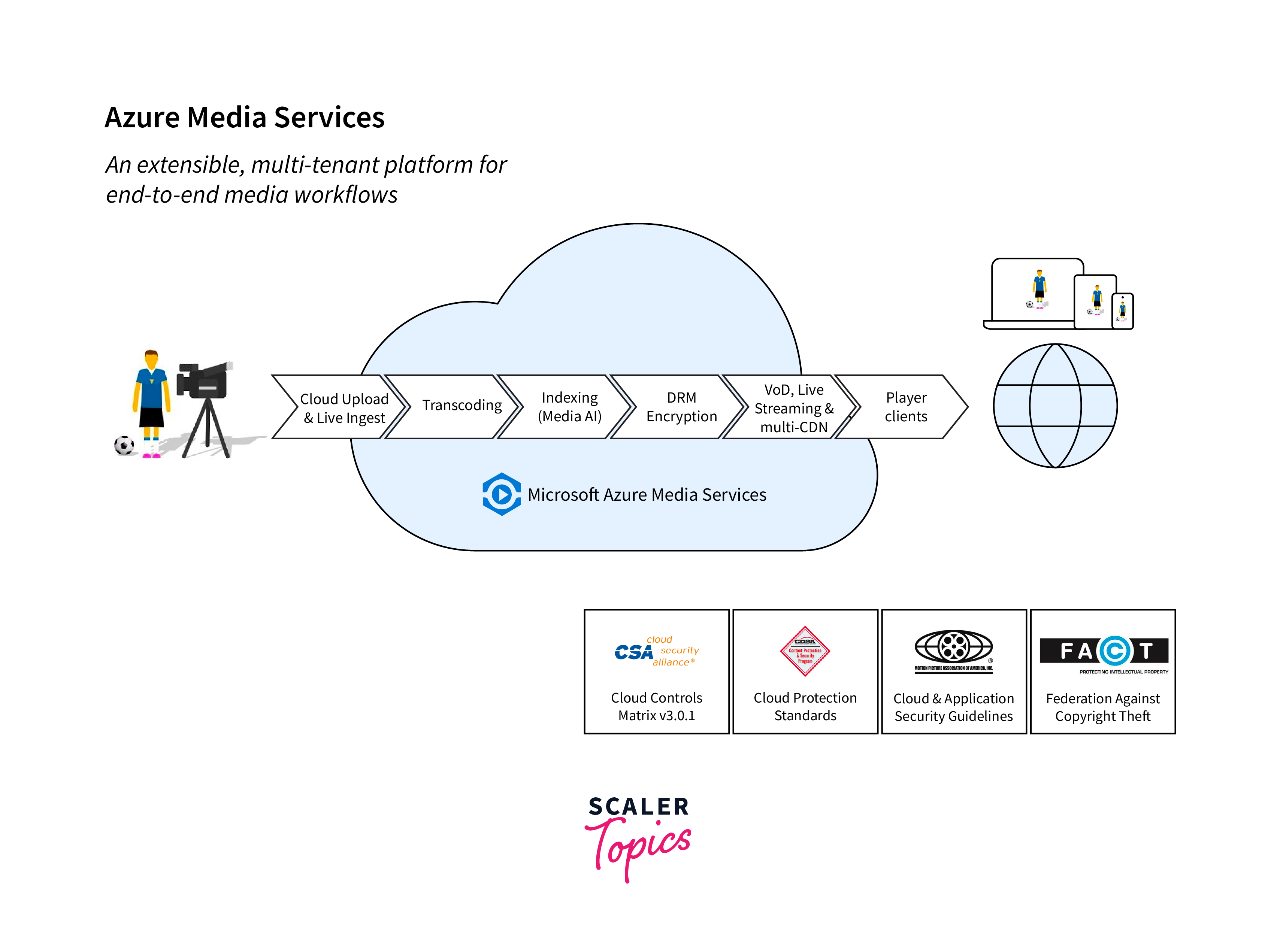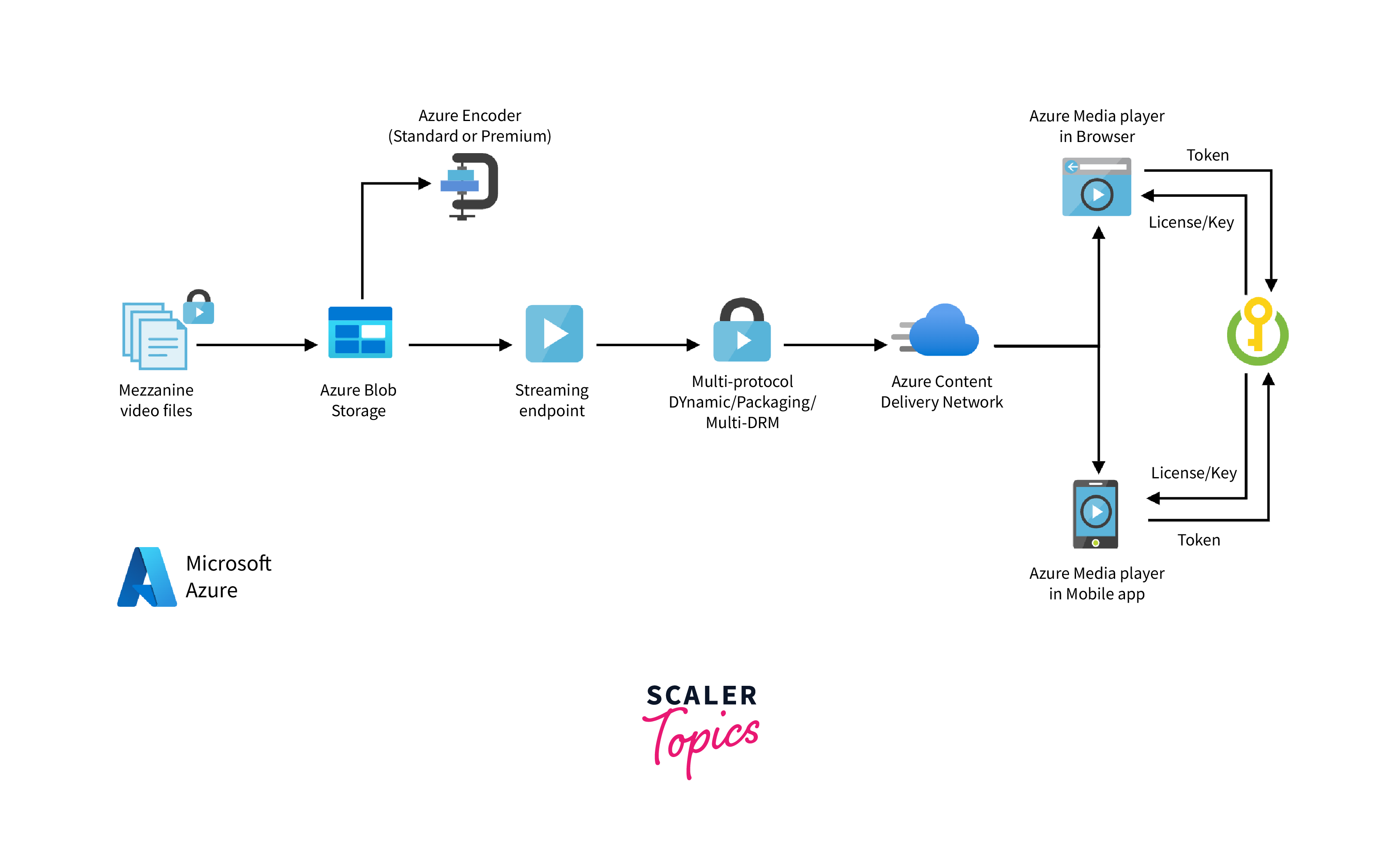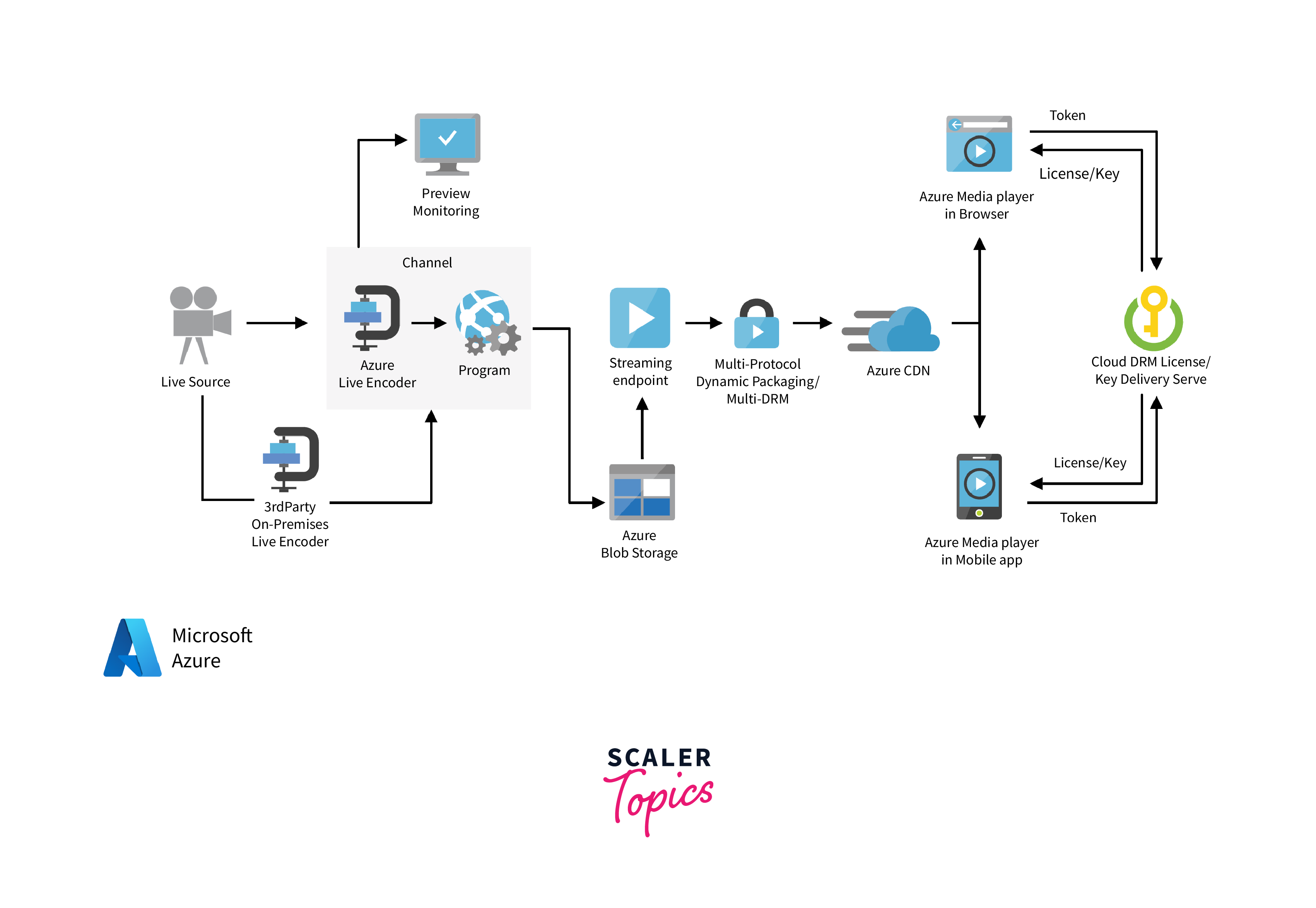Azure Media Services
Overview
Azure Media Services, a component of Microsoft's Azure cloud platform, provides an advanced suite of tools for managing, processing and delivering digital media content. It offers scalable solutions to efficiently handle media workloads of varying sizes, making it ideal for content creators, media companies, and organizations aiming to utilize media in diverse communication and marketing strategies. This service simplifies complex tasks like encoding, content protection, and streaming, thus empowering users to focus on creating and distributing high-quality media content across various platforms.
What can You do with Media Services?
With Azure Media Services, users can leverage cloud-based capabilities to build diverse media workflows:
-
Video and Audio Delivery:
Azure Media Services enables the delivery of videos in various formats, ensuring compatibility with a wide range of browsers and devices. This includes both on-demand and live streaming delivery to clients such as mobile devices, TVs, and PCs.
-
Live Streaming of Sporting Events:
The service can stream live sports events to a broad audience, encompassing soccer, baseball, college, and high school sports.

-
Broadcasting Public Meetings and Events:
Users can broadcast public events like town halls, city council meetings, and legislative sessions.
-
Media Content Analysis:
Azure Media Services allows for the analysis of recorded videos or audio content. Organizations can extract speech-to-text for building search indexes and dashboards, and gather intelligence on customer feedback, complaints, and other relevant data.
-
Subscription Video Services:
The platform supports the creation of subscription video services and the streaming of DRM-protected content, catering to customers who need to restrict access to proprietary copyrighted work.
-
Offline Content Delivery:
It facilitates the delivery of offline content for playback in situations like flights or road travel, where users might be disconnected from the network.
-
Scalability with Azure CDN:
Azure Media Services integrates with Azure CDN for large-scale deployments, effectively managing high loads, such as during product launch events.
Media Services Concepts
Azure Media Services encompasses several core concepts that are integral to its operation and functionality:
-
Assets:
The primary unit of management in Azure Media Services, assets represent digital files like videos, audio, images, and other multimedia content.
-
Streaming Endpoints:
These are responsible for delivering content to the end-users. They can be scaled to handle varying loads and can be integrated with CDN for wider distribution.
-
Jobs and Tasks:
Jobs in Azure Media Services are used to process media files. Each job can contain multiple tasks, such as encoding or adding subtitles, which are executed in a specified order.
-
Live Events:
This concept refers to the live streaming capabilities of Azure Media Services, allowing for broadcasting live content such as sports or news.
-
Content Protection:
Azure Media Services provides options for securing media content, including encryption and digital rights management (DRM) to control access and distribution.
-
Analytics and Insights:
The service offers tools for analyzing viewer engagement and usage patterns, helping creators and businesses to understand their audience better.
Azure Media Services Architecture
The architecture of Azure Media Services is designed to efficiently handle both video-on-demand delivery and live streaming.
Video-on-demand Delivery
Azure Media Services facilitates the encoding, storing, and then streaming of media content on demand. It involves the conversion of raw video files into various formats and bitrates to support different devices and bandwidth conditions. After encoding, these files are stored in Azure Blob Storage and are ready for streaming through Azure's robust CDN (Content Delivery Network).

The primary elements of Video on Demand within Azure Media Services include:
-
Blob Storage:
This component stores large amounts of unstructured data, accessible globally via HTTP or HTTPS. It's versatile for public data access or for securing confidential application data.
-
Azure Media Services Encoder:
A key process in Media Services, encoding tasks are used to transform media files from one format to another through the creation of encoding jobs.
-
Streaming Endpoint:
Part of Azure Media Services, this service streams content to client player applications or to a CDN for wider distribution.
-
Content Distribution Network (CDN):
Ensures secure and reliable content delivery on a global scale, backed by an extensive feature set.
-
Azure Media Player:
Leveraging industry standards like HTML5 (MSE/EME), it offers an adaptive streaming experience. Developers can tap into a unified JavaScript interface for accessing APIs, irrespective of the playback technology in use.
-
Multi-DRM Content Protection:
Securely delivers content using multi-DRM (PlayReady, Widevine, and FairPlay Streaming) or AES clear key encryption to protect the content.
Live Streaming
In live streaming scenarios, Azure Media Services captures live feeds, encodes them in real-time to support various devices, and delivers the content through live streaming endpoints. This process is crucial for broadcasting events in real-time with minimal latency.

The elements of the live streaming setup in Azure Media Services are:
-
Blob Storage:
This stores large quantities of unstructured data, accessible from anywhere via HTTP or HTTPS. Blob storage is versatile, allowing for both public data access and private storage of application data.
-
Partner On-Premises Live Encoder:
This component sends out the live source using RTMP(S), or Smooth Streaming, for cloud ingestion.
-
Streaming Endpoint:
An Azure Media Services feature, this streaming service delivers content to client player applications or to a CDN for broader distribution.
-
Content Distribution Network (CDN):
Provides secure and reliable content delivery on a global scale, complete with a wide range of features.
-
Azure Media Player:
Offers an immersive adaptive streaming experience through standard technologies like HTML5 (MSE/EME). Developers can utilize a singular JavaScript interface for API access, regardless of the underlying playback technology.
-
Preview Monitoring:
Enables the previewing and verification of a live feed before it undergoes further processing and distribution.
-
Multi-DRM Content Protection:
Safeguards content delivery using multi-DRM (PlayReady, Widevine, and FairPlay Streaming) or AES clear key encryption to ensure content security.
To clearly distinguish between the features and components used for real-time streaming and on-demand content delivery in Azure Media Services, the following table provides a concise comparison:
| Feature/Component | Real-Time Streaming | On-Demand Content Delivery |
|---|---|---|
| Blob Storage | Used for temporary storage during live events | Stores processed on-demand content |
| Live Encoder | Captures and sends live feed for cloud ingestion | Not typically used |
| Streaming Endpoint | Delivers live stream to viewers | Delivers on-demand content to viewers |
| Content Protection | Secures live streams with DRM/AES encryption | Secures on-demand content with DRM/AES encryption |
| Azure Media Player | Plays back live stream content | Plays back on-demand content |
| CDN Integration | Ensures fast, global delivery of live streams | Ensures fast, global delivery of on-demand content |
| Preview Monitoring | Monitors live feed before distribution | Not used in on-demand scenarios |
Azure Media Services v3
Azure Media Services v3, the latest iteration of Microsoft's media services offering, marks a significant evolution in media processing and delivery capabilities. This version introduces a more streamlined API, enhancing developer productivity and simplifying integration with other Azure services. It focuses on advanced media workflows, offering improved encoding, content protection, and live event broadcasting features. With a strong emphasis on scalability and cloud efficiency, Azure Media Services v3 enables seamless handling of high-volume media tasks. Here are some code snippets demonstrating how developers can interact with this API, showcasing the streamlined features of version 3:
To interact with Azure Media Services v3, you need to authenticate using Azure Active Directory (Azure AD). Here's a basic example in C#:
To upload and encode a video, you can use the following approach:
To create a streaming endpoint:-1:
Advantages of Using Azure Media Services
Azure Media Services offers several compelling advantages:
-
Scalability and Flexibility:
Azure Media Services can effortlessly scale to meet the demands of both small-scale projects and large, enterprise-level operations. This flexibility ensures efficient handling of varying workloads without the need for extensive infrastructure investments. Consider the case of a major sports league using Azure Media Services to stream games globally. With the ability to scale up resources during peak times, like playoffs or finals, the service ensures uninterrupted streaming even with millions of concurrent viewers.
-
Global Reach with Azure CDN:
Integrated with Azure's Content Delivery Network (CDN), it ensures fast and reliable delivery of content across the globe, reducing latency and improving user experience. An educational platform using Azure Media Services to deliver lectures and educational content globally is another example. This service ensures that students in different parts of the world receive high-quality video content with minimal latency, making education more accessible and engaging.
-
Advanced Media Processing:
It provides sophisticated tools for tasks like encoding, live event broadcasting, and content protection, simplifying complex media workflows.
-
Content Security:
Azure Media Services offers robust security features, including multi-DRM and AES encryption, ensuring that content is securely stored and delivered.
Case Studies
- NBC Sports used Azure Media Services for the 2016 Rio Olympics to provide live and on-demand multi-platform streaming. The scalability of Azure was crucial in handling the massive influx of viewers, which numbered in the millions.
- Airline company JetBlue leveraged Azure Media Services to enhance in-flight entertainment by providing a diverse range of on-demand content to passengers. Azure's scalable and flexible media delivery system was key to offering a high-quality, personalized entertainment experience.
Azure Media Services Pricing
Here's a table summarizing the key components of Azure Media Services pricing:
| Component | Description |
|---|---|
| Pay-As-You-Go | Users pay only for the resources used, allowing for cost-effective scaling. |
| Encoding Pricing | Costs depend on the amount of content processed and the complexity of encoding tasks. |
| Streaming Costs | Calculated based on data streamed and geographic distribution; influenced by Azure CDN integration. |
| Storage Fees | Associated costs for storage space and data transfer in Azure Blob Storage. |
| Content Protection | Charges for DRM and other content protection services are based on usage. |
| Live Event Pricing | Determined by the duration and resources used for live streaming events. |
| Additional Services | Costs for additional Azure services like advanced analytics or machine learning. |
Conclusion
- Azure Media Services offers a full spectrum of tools for video on demand, live streaming, content protection, and analytics, catering to a wide range of media needs.
- Its ability to scale according to demand makes it suitable for both small-scale projects and large enterprise needs, ensuring cost-efficiency and performance.
- Integrated with Azure CDN, it ensures fast and reliable global content delivery, enhancing user experience. Robust security features, including multi-DRM and AES encryption, provide peace of mind for content protection.
- Being part of the Azure platform, it offers seamless integration with other Azure services, enhancing capabilities and creating synergies in cloud computing and media delivery.
